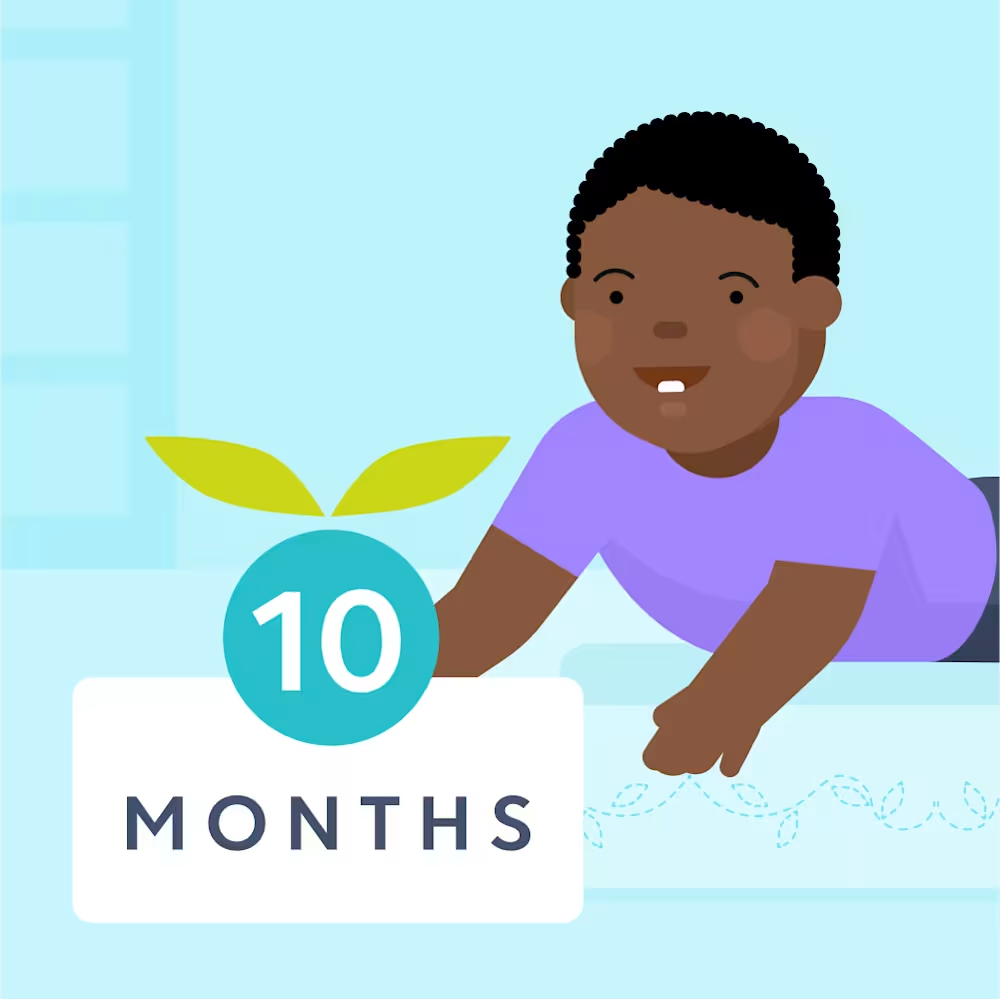10 month sleep regression: Myth or real?
Updated Dec 02, 2025

If your little one is going through a rough patch of sleep at 10 months, you may be grasping at straws trying to figure out what’s going on — and how long it will last. The short version is that sleep regressions (meaning sudden worsening of sleep patterns) can happen at any age. Maintaining healthy sleep habits can lessen their impact and length.
In this article, we’ll help you identify sleep regression signs, provide parent tips for handling sleep issues at this age, and give you resources to help your child learn to sleep independently, which often leads to improved sleep.
If you’re looking for a little extra support in the sleep department, whether or not you feel your little one is in a 10 month sleep regression, consider submitting for a sleep plan through. Our step-by-step plans are tailored to help your child’s sleep get back on track.
Table of Contents
Is there a 10 month old sleep regression?
While can occur at any age, there are often patterns within particular age ranges that contribute to a worsening of sleep. Between 7 - 10 months, babies become more mobile, cut teeth, and transition to two naps, which may lead to new sleep challenges. If your 10 month old is experiencing new sleep challenges (like fighting sleep, short naps, increased waking overnight, etc.) when they had been sleeping better previously, some might call this a “10 month sleep regression.” However, there’s not a magical date on the calendar that sets a patch of rocky sleep in motion at this age — every child is different!
Why do 10 month old babies have sleep issues?
Reason #1: Sleep onset associations
We find that independent sleepers [] tend to have an easier time at bedtime, longer naps, and fewer nighttime wakes since they’re able to fall asleep on their own and link sleep cycles without parental help. If your kiddo is regularly helped to sleep (fed, rocked, etc. until asleep), this may result in a sleep onset association that contributes to short naps and increased overnight waking. It’s perfectly fine if you prefer to continue helping your child to sleep. However, if you’re feeling stuck and want to make a change,!
Reason #2: Discomfort
If your little one is fussy at night, it could be due to some sort of discomfort, whether from or sickness. Understandably, babies tend to have a harder time sleeping when they’re in pain or congested. Usually, this type of discomfort only lasts a few days to a week, and returning to your typical sleep routine as soon as they’re feeling better can on their sleep.
Reason #3: Separation anxiety
At 9 - 10 months, may be contributing to your child’s sleep issues and may look like intense crying or clinginess at bedtime. Children in this age group have typically started to physically explore away from you (thanks to new skills like crawling) and this newfound freedom can be accompanied by anxiety over the realization that they’re not attached to you. You’ve been the person they’ve relied on for all of their needs and it can be jarring when they discover that you’re two separate people!
On top of this, babies at this age are developing a sense of object permanence, meaning they can now grasp that you still exist even when you’re out of sight. Crying is how little ones express their desire for you to come back.
Reason #4: Developmental milestones
Watching your little one achieve motor milestones is so gratifying, however, these big wins can disrupt sleep []. Babies become less excited about sleep and more excited to try out these new skills at bedtime! Usually, the novelty wears off after a couple of weeks.
My 10 month old won’t nap so is this a sleep regression?
At this age, we expect babies to have somewhere around per day, spread over two naps. Ideally, each nap is about 1 - 2 hours long. Sleep regressions can impact naps, so if your baby is suddenly taking shorter naps or skipping naps at 10 months, this could be a sign of a sleep regression. However, wake windows tend to expand at 10 months, which can also lead to short or skipped naps, so you may consider a schedule change to see if this improves daytime sleep.
If daytime sleep troubles aren’t new and your 10 month old is consistently having trouble falling asleep and staying asleep for naps, it could also be due to the way they’re falling asleep. When babies develop a that stems from being helped to sleep (rocking, feeding to sleep, etc.), we often see shorter naps and more frequent nighttime wakings. Teaching your little one to is often the most important step to improving day sleep.
How long does the "10 month sleep regression" last?
The length of sleep regressions typically depends on the cause and the strategies you’re using to get sleep back on track.
When does it start?
Contrary to popular belief, there aren’t prescribed start dates for sleep regressions (save for the physiological changes that occur during the “”). Instead, there are some sleep regression signs to watch for:
Sudden worsening of night sleep
Baby is fussy and has difficulty settling down for sleep
Short naps and baby is sleeping less during the day
Baby is distracted during daytime feedings
When does it end?
Unfortunately, there’s no magic end date for sleep regressions. You might expect a short period of disrupted sleep if the regression is prompted by an illness, teething, or developmental milestone. However, if you have during this period of discomfort (like rocking or feeding to sleep), this can prolong sleep challenges. In this case, you may find the period of sleep trouble lasts longer — weeks or months. To get sleep back on track, it can be helpful to reset your little one’s expectations at bedtime.
| Issue | Symptoms | Typical duration | Ways to manage |
|---|---|---|---|
| Teething | Drooling, chewing on objects, mild irritability | About a week | Try to stick to normal bedtime routine as much as possible. Provide extra comfort as needed. |
| Separation anxiety | Intense crying, clinginess, avoiding other caregivers | Varies | Take time to introduce new places and people, offer extra support |
| Illness | Discomfort, new sleep struggles | Varies | Offer comfort, consult pediatrician regarding medication or other intervention |
| Need for schedule adjustment | Fighting sleep, short naps, early waking | Requires adjustment before resolving | Consider increasing wake window or dropping a nap if age-appropriate |
| Developmental milestones | New fussiness around sleep, preference for practicing new skills | Few weeks | Encourage baby to practice new skills during wake times |
How can I tell if it's separation anxiety or 10 month sleep problems?
at 10 months is one of many factors that can result in sleep problems. It isn’t one or the other. As we explained above, separation anxiety usually kicks in after 8 months, when your little one is newly exploring away from you thanks to their new motor skills. This leads to the realization that they’re not physically attached to you, their primary caregiver. What big, scary news for a kiddo! On top of that, they also now understand object permanence: You exist even when they can’t see you. These realizations can lead to lots of tears and clinginess at sleep times when it’s time to separate from you.
How do I know if it's teething or 10 month sleep regression?
The discomfort and pain may be another factor that leads to poor sleep at 10 months. Your baby may be getting quite a few teeth — the central and lateral incisors can erupt around this time. Fortunately, teething pain typically only lasts about a week. A study [] found that teething symptoms tend to occur over 8 days: 4 days before a tooth emerges, the day the tooth erupts, and the 3 days after.
Teething can be at the root (ha!) of a sleep regression at 10 months and the hope is that once the discomfort from new teeth ends, sleep will improve. To avoid prolonging sleep issues during this period, go ahead and offer extra snuggles to comfort your little one but try to stick to your normal bedtime habits as much as possible.
4 tips to handle 10 month old sleep issues
Tip | Why it helps | What to try |
|---|---|---|
Consider a set “by the clock” schedule | Predictable sleep and wake times help regulate your baby’s body clock. | Plan naps and bedtime roughly the same times each day, using 3 - 3.75 hours of awake time between sleep periods as a guide. |
Establish a consistent bedtime routine | Familiar steps signal that sleep is coming and help your baby wind down. | Follow a simple, soothing sequence (like bath, feed, lullaby, lights out) and do it in the same order each night. |
Offer time to practice new skills | Mastering new motor skills (like standing or crawling) can temporarily disrupt sleep. | Give your baby floor time to explore and practice during the day so they’re less eager to move at bedtime. |
Consider sleep training | Independent sleep skills help reduce night wakings and support longer stretches of sleep. | Choose a method that fits your family and make sure your baby is healthy and feeling well before beginning. |
Find more details below:
Tip #1: Consider a set “by the clock” schedule
A good way to reduce night wakings is by making sure your little one's not overtired at bedtime. generally have a harder time falling asleep and staying asleep. Now that your baby is 10 months and may be ready for a more predictable sleep schedule, consider planning their naps and bedtime at around the same time every day, rather than strictly according to wake windows — which can lead to a lot of variabilities. Consistent sleep and wake times help regulate a baby’s circadian rhythm, making it easier for them to sleep well.
However, remember that a “by the clock” schedule doesn’t disregard wake windows. When scheduling their sleep times, note that most children this age need around 3 - 3.75 hours of awake time before they’re ready to snooze again. Ideally, your child’s schedule will take these age-appropriate wake windows into account.
Tip #2: Establish a consistent bedtime routine
A can be a great way to help your child wind down and understand that sleep is going to come next. An example of a baby’s routine may look like this:
Bath
Diaper change and pajamas
Breastfeed or bottle-feed
Dim lights and sleep sack on
Read a board book while snuggling
Sing a lullaby
Turn off lights, kiss goodnight, and lay baby down awake in a crib
This is just one example of what a bedtime routine may look like — feel free to modify and include activities that fit your schedule and preferences.
It’s best if the routine you choose is done in the same order every night (you could do a shorter, modified version for naptime).
Tip #3: Offer time to practice new skills
Babies are so thrilled by their own mastery of motor skills that they often want to practice these new moves when they’re. It’s common and expected, even though it’s frustrating. To avoid bedtime turning into playtime, try giving your little one plenty of time to practice new skills (standing, crawling, etc.) during awake times throughout the day. Rest assured this is just a phase it may take a few weeks before they master the skill and it no longer impacts sleep.
Tip #4: Consider sleep training
Helping your child learn to fall asleep independently when it’s developmentally appropriate can be a big step toward improving sleep. If you’ve been helping your little one fall asleep, whether it’s rocking, feeding, or holding, this creates a that can lead to more night wakes and shorter naps. If this isn’t working for your family any longer, you might consider a
Some methods have a more gradual, gentle process and some have a approach. It’s important to that seems like a good fit for your child and your parenting style. Note that we don’t recommend sleep training if your little one is experiencing discomfort from sickness. Instead, give them time to feel better before beginning a new sleep training method.
How much sleep does a 10 month old need?
At 10 months old, we recommend aiming for about 13.5 hours of total sleep per day. This often breaks down to 11 - 12 hours at night and 2 - 3 hours of daytime sleep over two naps. If your little one is sleeping more or less than this, chances are that’s normal too — sleep totals are just a rough estimate. It's equally important to check in on your little one's mood and energy levels to determine whether they're getting the sleep they need.
Can you sleep train during a sleep regression?
By around , many babies are developmentally ready for sleep training, even if they're going through challenging sleep phases. There are several approaches to help your baby learn to fall asleep independently — ranging from gentle, gradual techniques to faster methods that may involve more initial crying. Sleep training is a personal choice, and only you can decide what feels best for your baby and your family.
Can I let my 10 month old cry it out during a sleep regression?
By around 10 months, many babies are developmentally ready for sleep training, even if they’re experiencing a sleep regression. There are many approaches to consider and the “right” choice depends on your family’s goals and comfort level. Gentle methods — like gradual withdrawal or pick-up-put-down — can support independent sleep while still providing reassurance.
For families looking for a quicker solution, more intensive methods like total extinction (or “”) may be a better fit, especially if check-ins seem to disrupt self-soothing and make your baby more upset. If you choose this approach, ensure your baby’s basic needs are met — they’re fed, dry, and comfortable — and use a video monitor along with regular safety checks to monitor their well-being.
As always, consider your baby’s overall health and development, and consult your pediatrician if you have any concerns before beginning sleep training.
What are self-care tips for tired parents?
Rest without the guilt: You know how as soon as your little one falls asleep, you want to sit around and give yourself a break, then you look around at the laundry piles, dishes, and the gazillion other things you should be doing? Instead of feeling guilty about scrolling on your phone for 15 minutes instead of doing chores, try giving yourself permission to do “nothing” — without feeling bad about it. These little resets can get you through the day!
Get outside: Sometimes getting outside in the fresh air can do wonders for you and your baby. Spend some time in the backyard or take a pre-dinner stroll around the block — changing the scenery and moving around can give everyone a little boost.
Ask for specific help: Even though you’re no longer in the throes of the newborn phase, help from a friend or family member can go a long way! However, it can be helpful to ask for assistance with intention — like asking a close friend to bring over dinner to lighten your load or assign your mom bath duties with your little one. Taking a specific task off your plate (even if it’s small) can make a big difference.
Should I let my baby sleep in my bed during a regression?
At 10 months, the American Academy of Pediatrics continues to strongly advise against bed-sharing due to safety concerns []. While many families do bed-share at some point, understanding the risks can help you make informed decisions that prioritize your baby’s safety.
If you bring your little one into bed for a cuddle or feeding, it’s safest to return them to a firm, flat sleep surface before you fall asleep. Sleeping with your baby on a couch or recliner is particularly dangerous and should be avoided [].
When to talk to a doctor
Sleep challenges are a normal (and often frustrating!) part of your baby’s development. Still, you know your baby best. If you’re ever concerned about their sleep patterns, worried they’re not getting enough rest, or notice anything out of the ordinary, it’s usually best to check in with their healthcare provider and err on the side of caution. Here are a few signs that may be worth discussing with their doctor:
Feeding or weight gain concerns: If your baby is regularly skipping feeds, producing fewer wet diapers, or not gaining weight as expected, it’s a good idea to reach out to their doctor. If you’re breastfeeding, a lactation consultant can also be a helpful resource.
Excessive fussiness or signs of discomfort: If your baby seems unusually fussy, is difficult to soothe, or appears to be in pain, it could be a sign of an underlying issue like reflux, an ear infection, or another illness that warrants medical attention.
Unusual symptoms: Signs like fever, rash, vomiting, or a persistent cough should be evaluated by a healthcare provider.
Excessive sleepiness: If your baby is sleeping significantly more than usual, seems overly drowsy, or is hard to wake, check in with their doctor.
Parental instincts: Trust your intuition! If something doesn’t feel right, don’t hesitate to reach out for support. Even if everything turns out to be fine, getting reassurance from your child’s doctor can offer you peace of mind.
Takeaway
At 10 months, patches of bumpy sleep can be due to factors like being helped to sleep, separation anxiety, illness, teething, and more. If your little one had been sleeping well and then suddenly experiences new sleep challenges, we’d call this a sleep regression.
One way to improve sleep at 10 months is through teaching your baby independent sleep skills. Sleep training is a personal decision and there are a variety of sleep training approaches, ranging from gentler methods that take more time to quicker strategies that may involve more crying upfront.
Sleep regressions are a normal part of your baby’s development. You can help your little one through these challenging phases by adjusting their sleep schedule, encouraging them to fall asleep independently, and giving them plenty of time to practice new motor skills during the day.
10 month sleep regression FAQ
Share article:
Note: The content on this site is for informational purposes only and should not replace medical advice from your doctor, pediatrician, or medical professional. If you have questions or concerns, you should contact a medical professional.
5 Sources
Table of Contents
Share article:







